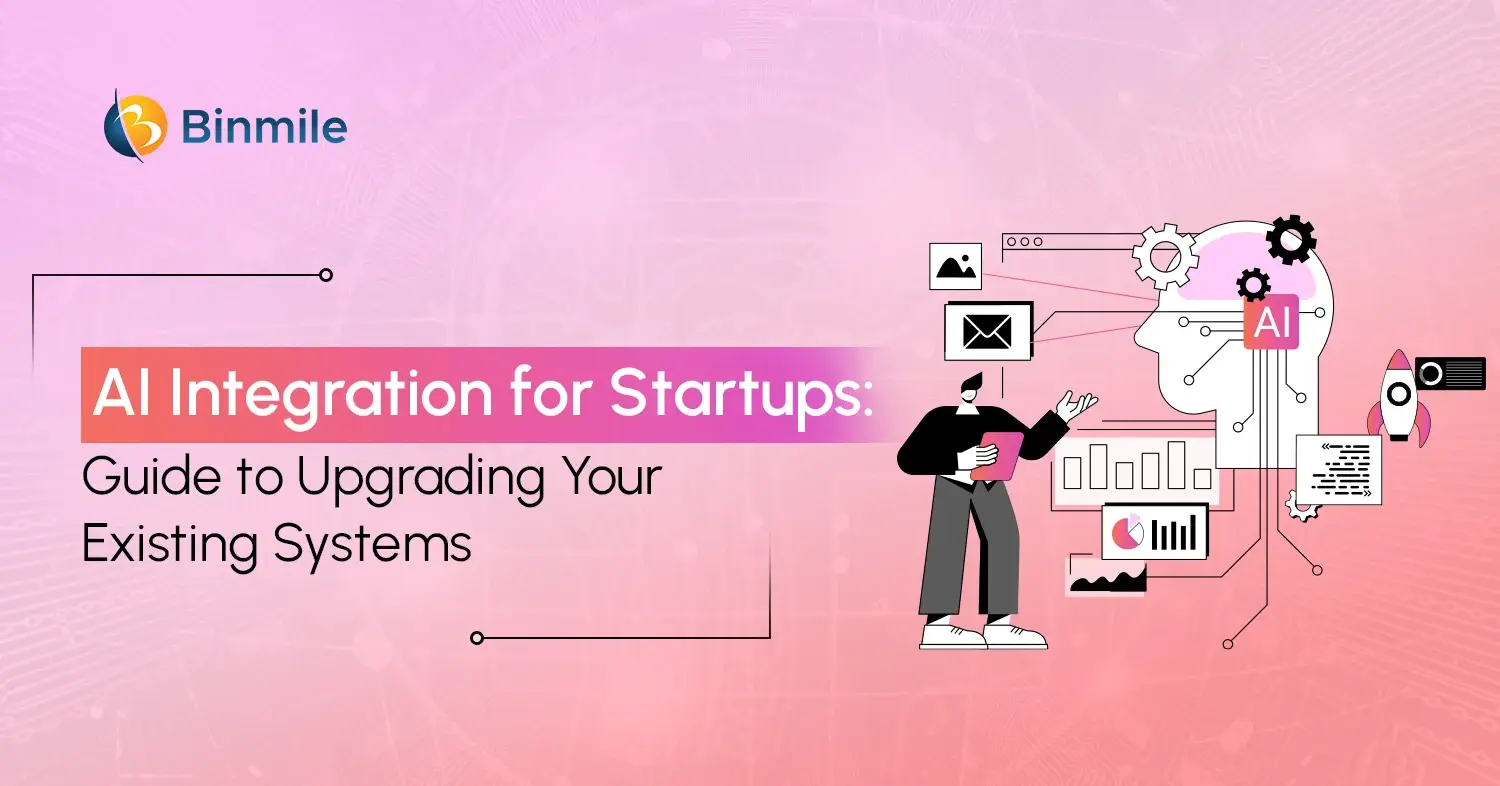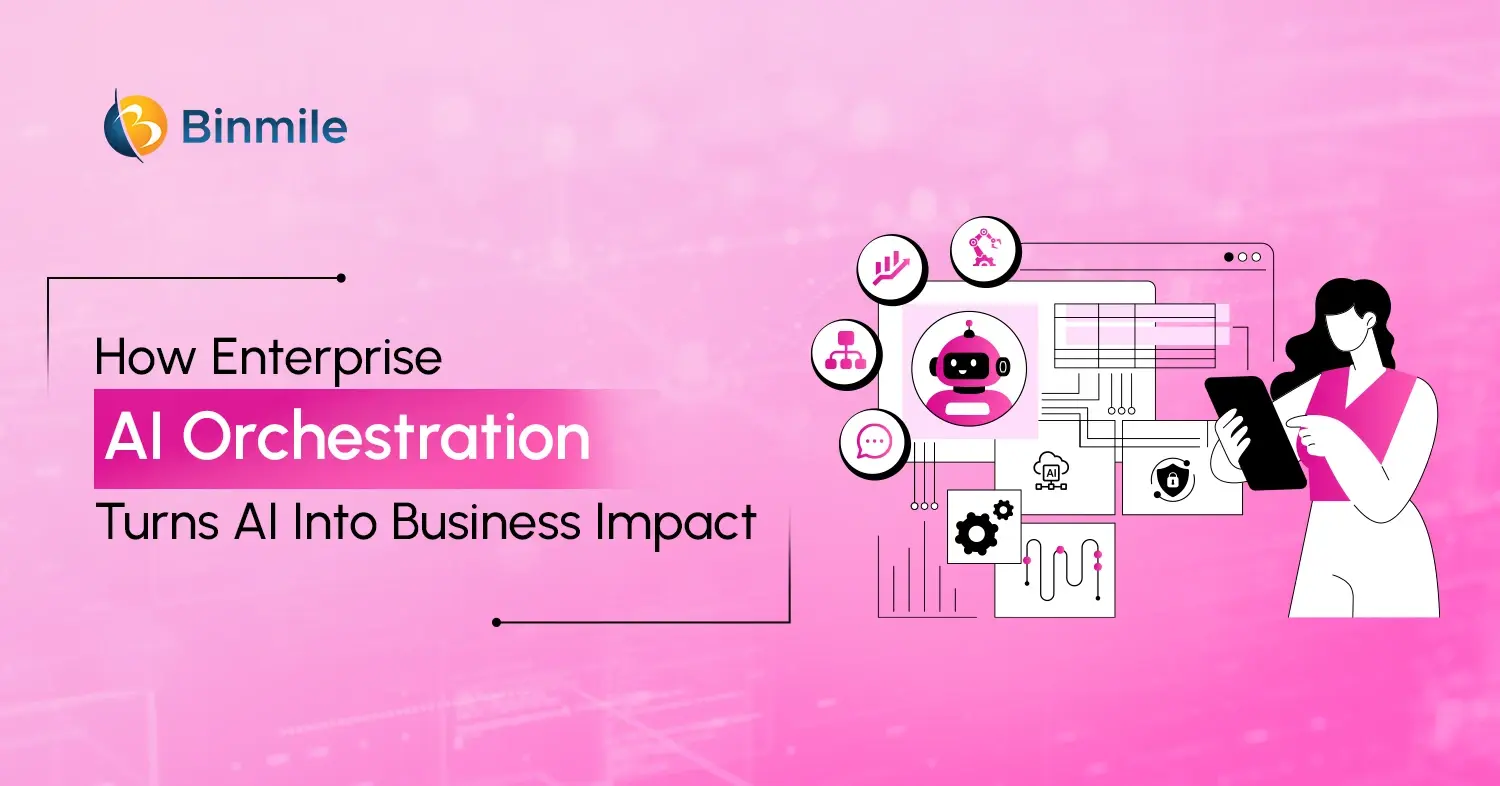Artificial intelligence is redefining business operations and is becoming a transformative force across industries. It also brings economic effects through optimization, increased efficiency, acceleration, and simplification of many processes that previously required significantly more resources and competencies. For startups, it offers unprecedented opportunities for growth and innovation by reinventing traditional business models. Undoubtedly, AI brings a transformative edge to start-ups, but truly harnessing its potential requires meticulous integration. It becomes more challenging if the AI is being merged with existing systems. So, what is the beginner’s guide to AI Integration for Startups into existing systems? Why is it important in the first place?
Effectively, AI business integration of existing systems is crucial because it allows businesses to leverage the power of artificial intelligence without the need to completely overhaul infrastructure. This leads to increased efficiency and productivity while minimizing disruption to current processes. Therefore, to fully realize the potential of AI requires careful planning, technical expertise, and a strategic approach. In this blog, we will explore 7 strategies that a start-up must adopt to successfully incorporate AI into existing systems. We will also share how AI adoption in start-up businesses brings immense benefits to the business.
7 AI Integration Strategies for Startups
What is the meaning of AI integration? As a process, AI integration focuses on leveraging artificial intelligence capabilities directly with products and systems rather than letting AI operate as an external tool. So, let’s explore how AI software development services can successfully integrate AI into your operations with this start-up guide to AI integration to help you get started:

1. Identify Opportunities & Set Clear Goals
Map out areas where AI can make the most impact on your operations with a thorough understanding of your current processes and pain points. Explore AI startup ideas that address repetitive, time-consuming, or prone to human error. This will help you stay focused and provide a benchmark for measuring success. So, consider:
- Prioritize identified opportunities based on impact and feasibility
- Use the SMART goal framework for a comprehensive review of current workflows.
- Identify repetitive, time-consuming, or error-prone tasks.
2. Find Yourself the Right AI Model
Selecting the right AI model for your applications or systems can be challenging with so many options available. However, understanding these models and finding the right one is key to harnessing the full potential of AI. Making an informed choice is what helps you choose an AI system that efficiently solves your problems rather than one that falls short of your objectives. So, to choose the one that best suits your business needs, focus on:
- Vendor’s track record and their ability to provide ongoing support
- Matching your specific needs, such as your in-house technical capabilities, and your budget
- Verifying that the AI model can integrate seamlessly with your current systems and data.
- Choosing a model that can adapt to your changing business needs and scale as your operations grow
3. Ensuring AI-Ready Data Availability
AI tools and systems can only work to wonder if the data they are trained on is of high quality. Therefore, before proceeding with any AI project, it is crucial to assess your data landscape to figure out what data you have, where it is stored, and how it is structured. If your data is not up to par, you may need to invest in upskilling your team that can train a model. Doing so helps your models learn patterns and make informed predictions. To ensure you have got enough high-quality, relevant data to train your AI models effectively, ask yourself:
- Is it sufficient in quantity and quality?
- Is it properly labeled, stored, and organized?
- Does your team have the skills to develop and fine-tune your model so that it delivers accurate results?
- Are there any privacy or security concerns?
- Who will be responsible for maintaining the data?
4. Start Small with a Pilot Project
Before rolling out AI across your entire organization, it is wise to start with a small-scale pilot project. This allows you to test your chosen AI solution in a controlled environment, minimizing risk and allowing for adjustments before a full-scale deployment. So, to test the project, do the following:
- Choose a specific, well-defined project for the pilot to ensure clear objectives and measurable outcomes.
- Set KPIs to assess its effectiveness and to identify potential issues
- Involve end users early to gather their insights and foster buy-in.
- Gather feedback from users and stakeholders.
5. Empowering Your Human Assets
The success of your AI integration largely depends on how well your team adapts to the new technology or IT trends. It is important to frame AI as a tool that enhances human capabilities rather than a replacement for human workers. This can help alleviate fears and foster a more positive attitude towards the new technology.
- Provide training on how to use and maintain the AI solution
- Address concerns about job displacement, ethical use, and data privacy
- Emphasize the benefits of AI augmentation
- Foster an environment where team members can share experiences and best practices.
6. Plan Merging AI with Your Ecosystem
This involves mapping out how the AI solution will fit into your current infrastructure and workflows. Also, involve stakeholders from different departments in this planning phase to ensure all POVs are considered and potential issues are addressed early. For this, consider both technical and operational aspects of the integration. In addition, during the rollout, ensure integration leads to minimal disruptions to existing workflows. Take the following actions for a successful integration:
- Engage with key stakeholders, provide training, and offer ongoing support
- Identify necessary changes to existing systems
- Determine hardware and software requirements
- Establish a timeline and allocate resources
- Plan for potential disruptions to current operations
7. Performance Tracking & Optimization
Your start-up guide to integrating AI into existing systems is incomplete without your monitoring and implementing changes whenever needed. To ensure the ongoing success of your AI integration, it is crucial to regularly track, evaluate, and iterate on your AI applications. Here are 4 tips to help you achieve this:
- Track key performance indicators
- Gather feedback from users and stakeholders.
- Continuously refine AI models and systems based on data and feedback
- Identify new opportunities or trends for applied AI applications in your organization.
Revolutionize your business for optimal performance, drive innovation, and maximize productivity with our AI integration solutions.

What are the Key Benefits of AI in Start-up Systems
So far, we have understood how AI Integration for startups can effectively utilize AI in their operations and change how they do business, from helping with boosting customer support to developing product ideas and prototypes. Let’s understand in detail how AI is helping the next generation of startups be more agile and disruptive:

-
Enhanced Efficiency & Productivity
AI can automate repetitive tasks, streamline workflows, and optimize processes, leading to increased efficiency and productivity. For example, AI in inventory management can optimize stock levels, reducing waste and ensuring timely restocking. Similarly, AI-powered chatbots can handle customer inquiries, freeing up human agents to focus on more complex issues
-
Personalized Customer Experiences
AI can be used to personalize customer interactions and experiences. By analyzing customer data, AI-powered systems can recommend products, provide tailored content, and offer personalized support.
-
Cost Reduction
AI can help reduce costs by automating tasks, optimizing resource allocation, and improving operational efficiency. For example, AI-powered predictive maintenance can help prevent equipment failures and reduce maintenance costs.
-
Improved Decision-Making
AI algorithms can analyze large datasets and identify patterns and trends that humans might miss. This enables startups to make more informed and data-driven decisions, reducing risks and improving outcomes.
-
Innovation and Product Development
AI can be used to develop innovative products and services that were previously not possible. For instance, AI in transport is transforming logistics with route optimization and predictive maintenance, reducing delays and fuel costs. Similarly, Tesla’s Autopilot is a semi-autonomous driving system. By utilizing the capabilities of AI, startups can create new business models, disrupt existing industries, and drive growth.
Elevate your project with our cutting-edge software engineering services, designed for maximum impact and scalability.

Examples of AI Integration for Startups: Real-Life Case Studies
-
Netflix:
Traditional recommendation systems struggled with user engagement and retention. AI-powered algorithms analyzed viewing patterns to deliver highly personalized content recommendations, significantly increasing watch time and subscription retention. Additionally, AI-optimized video compression ensures seamless streaming.
Key Impact: Enhanced personalization, improved engagement, and greater scalability.
-
Tesla:
Human-driven vehicles introduced inefficiencies, errors, and safety risks. The development of autonomous driving technology required real-time processing of sensor data. AI-driven neural networks powered Tesla’s Autopilot and Full Self-Driving (FSD) systems, reducing accidents, improving traffic efficiency, and enhancing overall road safety.
Key Impact: Minimized human error and improved transportation safety.
-
Amazon:
Managing large-scale logistics necessitated efficient inventory control, demand forecasting, and automation. AI-powered predictive analytics and robotic automation optimized inventory management, minimized waste, and expedited deliveries. Additionally, dynamic pricing models driven by AI enhance competitiveness.
Key Impact: Streamlined logistics, increased efficiency, and cost reduction.
-
Spotify:
Conventional recommendation models limited content discovery and user retention. AI-driven systems analyzed user behavior to generate personalized playlists, fostering higher engagement and subscription growth.
Key Impact: Improved user experience, enhanced customer retention, and increased engagement.
-
Stitch Fix:
Generic product recommendations resulted in high return rates and inventory inefficiencies. AI-powered analysis of purchase history and customer feedback enabled highly personalized fashion recommendations, reducing returns and enhancing customer satisfaction.
Key Impact: Enhanced personalization, optimized inventory management, and revenue growth.
-
Zebra Medical Vision:
Traditional radiology methods were time-consuming and prone to errors, leading to inefficiencies in medical imaging. AI-powered automation streamlined disease detection in scans, reducing diagnosis times by 80%, improving early detection, and lowering healthcare costs.
Key Impact: Improved diagnostic accuracy, increased efficiency, and optimized healthcare workflows.
Also Read: Why AI Fails in Enterprises?
How Much Does It Cost to Implement AI Integration for Startups
The cost of integrating AI into an existing system varies based on complexity, industry, and implementation scale.
- Basic AI Integration: $10,000 – $100,000
- Mid-Level AI Implementation: $100,000 – $500,000
- Enterprise-Level AI Deployment: $500,000 – $5M+
Below is a detailed breakdown of the key cost factors with estimated costs:
| Cost Component | Estimated Cost Range | Details |
|---|---|---|
| Custom AI Development | $50,000 – $500,000+ | Cost depends on complexity, model training, and customization. |
| Pre-Built AI Solutions | $5,000 – $100,000 | Includes AI-powered chatbots, automation tools, and pre-trained models. |
| Cloud AI Services (AWS, Google Cloud, Azure) | $0.01 – $5 per API call | Usage-based pricing for AI model hosting and processing. |
| On-Premise AI Servers | $100,000 – $1M+ | Required for high-performance AI processing. |
| Cloud AI Computing | $1,000 – $50,000+ per month | Costs depend on storage, processing power, and model complexity. |
| Data Collection & Cleaning | $10,000 – $100,000 | Depends on data volume, quality, and preprocessing needs. |
| Data Storage & Management | $1,000 – $20,000 per year | Cloud or on-premise data storage solutions. |
| Model Training | $10,000 – $250,000 | Costs vary based on iterations, dataset size, and computing power. |
| Ongoing Maintenance & Updates | $5,000 – $50,000 per year | Covers continuous optimization and bug fixes. |
| API Integration (e.g., ChatGPT, IBM Watson) | $5,000 – $50,000 | Connecting AI tools to existing business systems. |
| Legacy System Compatibility & Customization | $20,000 – $200,000+ | Adjusting old systems to support AI-powered workflows. |
| Hiring AI Engineers & Data Scientists | $100,000 – $250,000 per year per expert | Salaries for in-house AI specialists. |
| Outsourcing AI Development | $25,000 – $150,000 per project | Costs vary based on team expertise and project scope. |
Conclusion
There is no doubt that AI tools will continue to impact the startup landscape moving forward; it is imperative for a software engineering company to fully realize its potential sooner rather than later. Thus, startup teams, whether small and scrappy or rapidly growing, need to understand that they can use AI for quicker, clearer communication, improved training, and boosted productivity. After all, the ever-evolving nature of tech means that those AI business trends that want to stay ahead need to embrace and adapt to AI and its advancements. However, without a beginner’s guide to AI integration for startups into existing systems, it might be exacting tasks. Especially, when there are enough experts in the industry to raise the question of the responsible use of AI and data privacy.
Though no two integration paths will be identical, if you adhere to structured roadmaps rooted in clear strategic visions, it empowers teams to chart courses optimized for their unique objectives. Moreover, it also enables you to enhance capabilities and efficiency without disrupting ongoing operations. Hopefully, this blog has given you a deep understanding of how to effectively merge AI with existing systems to transform operations, offering smarter solutions and insights.
Frequently Asked Questions
AI Integration for Startups means adding AI tools, automation, and smart systems into your current processes to improve speed, accuracy, and efficiency.
The cost of integrating AI into business varies by project scope and technology. Small-scale AI solutions may cost a few thousand dollars, while enterprise-level AI system integration can range from $100,000 to millions. Consider long-term ROI when budgeting.
AI works best in customer support, marketing automation, sales forecasting, product recommendations, workflow automation, and data analysis.
While integrating AI into business offers advantages, common challenges include:
- Data Quality: Poor-quality data affects AI accuracy.
- Change Management: Resistance to new technologies.
- Cost of Implementation: Initial investment can be significant.
- Security Concerns: Safeguarding sensitive data during AI system integration.
- Talent Shortage: Finding skilled professionals for AI management.
The best time is when your team is spending too much time on manual tasks, missing growth opportunities, or handling more customers than your systems can manage.
Useful options include machine learning, generative AI, automation bots, NLP chatbots, predictive analytics, and AI-powered CRMs.
Binmile helps startups integrate AI into their existing systems by offering end-to-end guidance, from identifying the right AI tools to building custom automation that fits your workflows. Our team analyzes where your startup can benefit the most, upgrades your current systems for AI readiness, and ensures smooth, secure integration without disrupting your operations.
We also help you adopt scalable AI solutions, improve data flow, and automate repetitive tasks so your team can focus on growth. With Binmile, you get expert support, faster implementation, and AI systems that work perfectly with your existing technology stack.









